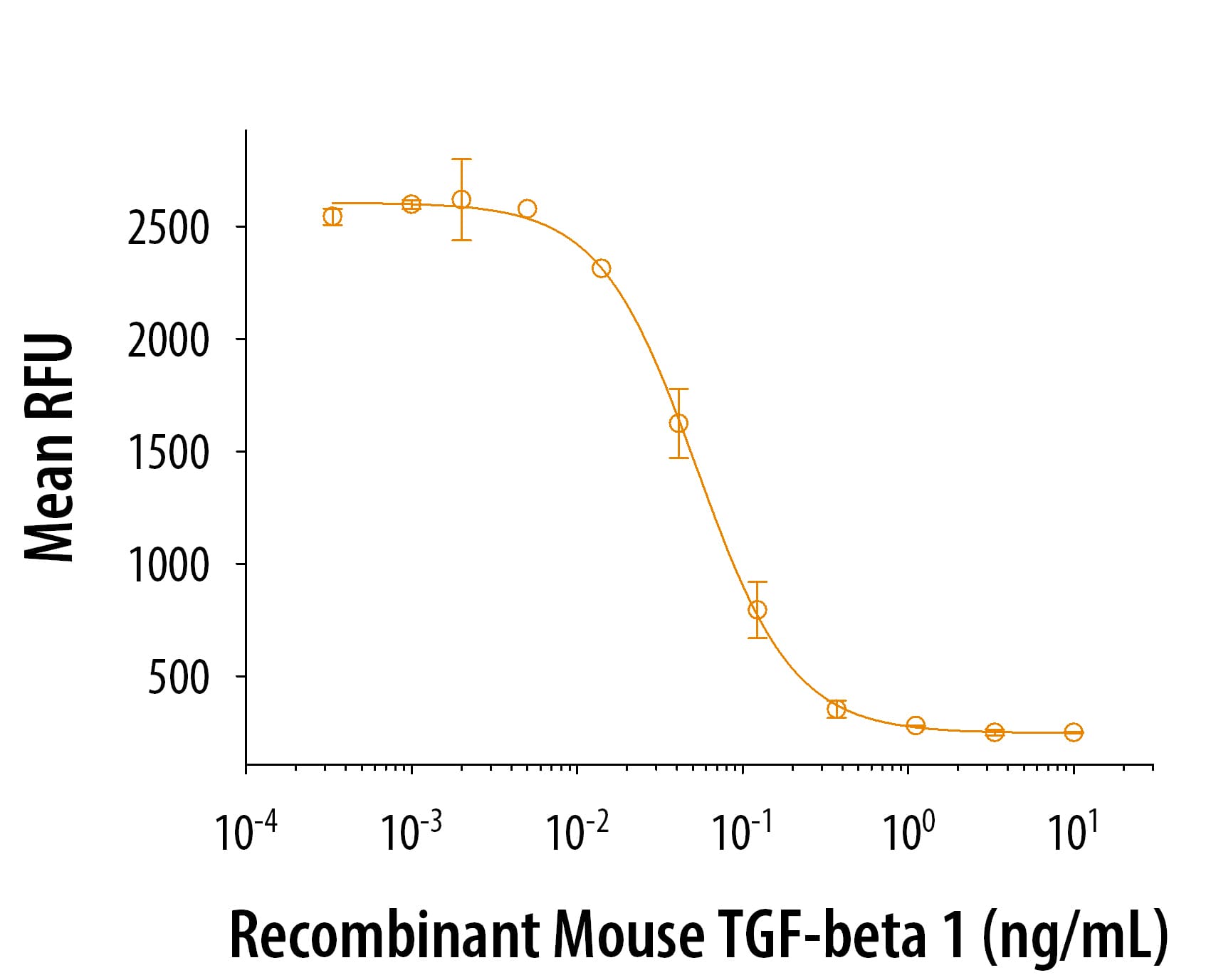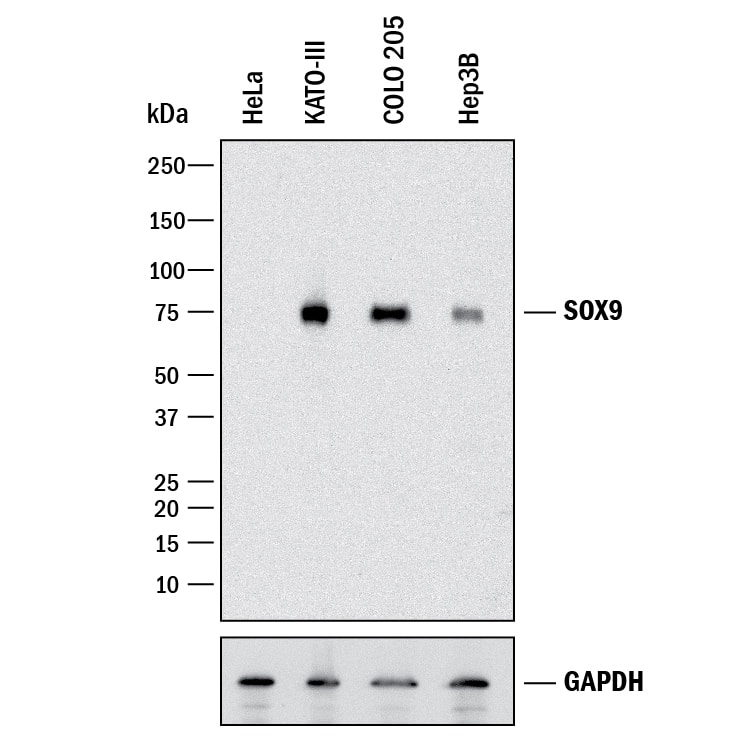Recombinant Mouse 4-1BB Ligand/TNFSF9 Protein Summary
Product Specifications
| Met | 10-His tag | GGGSGGGSGGGSIEGR | Mouse 4-1BB Ligand (Arg104-Glu309) Accession # P41274 |
| N-terminus | C-terminus | ||
Analysis
Customers also Viewed
Product Datasheets
Carrier Free
CF stands for Carrier Free (CF). We typically add Bovine Serum Albumin (BSA) as a carrier protein to our recombinant proteins. Adding a carrier protein enhances protein stability, increases shelf-life, and allows the recombinant protein to be stored at a more dilute concentration. The carrier free version does not contain BSA.
In general, we advise purchasing the recombinant protein with BSA for use in cell or tissue culture, or as an ELISA standard. In contrast, the carrier free protein is recommended for applications, in which the presence of BSA could interfere.
1246-4L
| Formulation | Lyophilized from a 0.2 μm filtered solution in PBS with BSA as a carrier protein. |
| Reconstitution | Reconstitute at 100 μg/mL in sterile PBS containing at least 0.1% human or bovine serum albumin. |
| Shipping | The product is shipped at ambient temperature. Upon receipt, store it immediately at the temperature recommended below. |
| Stability & Storage: | Use a manual defrost freezer and avoid repeated freeze-thaw cycles.
|
1246-4L/CF
| Formulation | Lyophilized from a 0.2 μm filtered solution in PBS. |
| Reconstitution | Reconstitute at 100 μg/mL in sterile PBS. |
| Shipping | The product is shipped at ambient temperature. Upon receipt, store it immediately at the temperature recommended below. |
| Stability & Storage: | Use a manual defrost freezer and avoid repeated freeze-thaw cycles.
|
Background: 4-1BB Ligand/TNFSF9
4-1BB Ligand (4-1BBL), also known as CD137L, is a type II transmembrane protein that belongs to the TNF superfamily of molecules and plays an important role in immune response activation (1). The approximately 50 kDa mouse 4-1BB Ligand consists of an 82 aa cytoplasmic domain, a 21 aa transmembrane segment, and a 206 aa extracellular domain (ECD) (2). Within the ECD, mouse 4-1BB Ligand shares 36% and 86% aa sequence identity with human and rat 4-1BB Ligand, respectively. 4-1BB Ligand is expressed by activated B cells, monocytes, macrophages, dendritic cells (DC), T cells, lymphoma and multiple myeloma cells, hematopoietic stem cells, early myeloid progenitors, neurons, and astrocytes (3-9). A 26 kDa soluble form of 4-1BB Ligand can be released from the surface of activated cells and retains bioactivity (10). 4-1BB Ligand binds to 4-1BB/TNFRSF9/CD137 on activated CD4+ and CD8+ T cells, thymocytes, and NK cells as well as on monocytes, neutrophils, DC, and eosinophils. In response to 4-1BB Ligand binding, 4-1BB transduces a co-stimulatory signal that promotes the proliferation, activation, and survival of CD4+ and CD8+ T cells (4, 11, 12). T cell co-stimulation through CD28 is important for the initial T cell expansion, while 4-1BB acts later in the response (12, 13). 4-1BB Ligand function supports the survival and responsiveness of memory T cells during viral infection (13-15). Reverse signaling through
4-1BB Ligand on monocytes induces the production of inflammatory cytokines (5). On macrophages, 4-1BB Ligand associates in cis with TLR4 and enhances inflammatory cytokine production in response to TLR4 ligation (6). Its expression on early myeloid progenitor cells limits the development of dendritic cells, monocytes, and B cells (9).
- Wang, C. et al. (2009) Immunol. Rev. 229:192.
- Goodwin, R.G. et al. (1993) Eur. J. Immunol. 23:2631.
- Reali, C. et al. (2003) J. Neurosci. Res. 74:67.
- DeBenedette, M.A. et al. (1997) J. Immunol. 158:551.
- Langstein, J. et al. (1998) J. Immunol. 160:2488.
- Kang, Y.J. et al. (2007) Nat. Immunol. 8:601.
- Baessler, T. et al. (2010) Blood 115:3058.
- Gullo, C. et al. (2010) PLoS One 5:e10845.
- Lee, S.-W. et al. (2008) Nat. Immunol. 9:917.
- Salih, H.R. et al. (2001) J. Immunol. 167:4059.
- Wen, T. et al. (2002) J. Immunol. 168:4897.
- Cannons, J.L. et al. (2001) J. Immunol. 167:1313.
- Bertram, E.M. et al. (2002) J. Immunol. 168:3777.
- Bukczynski, J. et al. (2004) Proc. Natl. Acad. Sci. USA 101:1291.
- Lin, G.H.Y. et al. (2009) J. Immunol. 182:934.
Citations for Recombinant Mouse 4-1BB Ligand/TNFSF9 Protein
R&D Systems personnel manually curate a database that contains references using R&D Systems products. The data collected includes not only links to publications in PubMed, but also provides information about sample types, species, and experimental conditions.
5
Citations: Showing 1 - 5
Filter your results:
Filter by:
-
Activation of 4-1BB signaling in bone marrow stromal cells triggers bone loss via the p-38 MAPK-DKK1 axis in aged mice
Authors: D Wan, S Ai, H Ouyang, L Cheng
Experimental & Molecular Medicine, 2021-04-15;0(0):.
Species: Mouse
Sample Types: Whole Cells
Applications: Bioassay -
Galectin-9 controls the therapeutic activity of 4-1BB-targeting antibodies.
Authors: Madireddi S, Eun S, Lee S, Nemcovicova I, Mehta A, Zajonc D, Nishi N, Niki T, Hirashima M, Croft M
J Exp Med, 2014-06-23;211(7):1433-48.
Species: Mouse
Sample Types: Protein
Applications: Bioassay -
Costimulation via the tumor-necrosis factor receptor superfamily couples TCR signal strength to the thymic differentiation of regulatory T cells.
Authors: Mahmud, Shawn A, Manlove, Luke S, Schmitz, Heather, Xing, Yan, Wang, Yanyan, Owen, David L, Schenkel, Jason M, Boomer, Jonathan, Green, Jonathan, Yagita, Hideo, Chi, Hongbo, Hogquist, Kristin, Farrar, Michael
Nat Immunol, 2014-03-16;15(5):473-81.
Species: Mouse
Sample Types: Whole Cells
Applications: Bioassay -
Regulation of innate CD8+ T-cell activation mediated by cytokines.
Proc Natl Acad Sci U S A, 2012-06-04;109(25):9971-6.
Species: Mouse
Sample Types: Whole Cells
Applications: Bioassay -
TNF superfamily member, TL1A, is a potential mucosal vaccine adjuvant.
Authors: Kayamuro H, Yoshioka Y, Abe Y, Katayama K, Yoshida T, Yamashita K, Yoshikawa T, Hiroi T, Itoh N, Kawai Y, Mayumi T, Kamada H, Tsunoda S, Tsutsumi Y
Biochem. Biophys. Res. Commun., 2009-05-04;384(3):296-300.
Species: Mouse
Sample Types: In Vivo
Applications: In Vivo
FAQs
-
This protein datasheet indicates I need to use a cross-linking antibody, Catalog # MAB050, for biological activity. What is this antibody and is it really necessary?
The antibody is directed against a 6x histidine repeat and is recommended for use as a cross-linker of proteins with 6x his-tag. Crosslinking is often used for proteins that require receptor trimerization and can result greater biological activity. R&D Systems Quality Control tests the performance of these proteins in the presence of the cross-linking antibody. Therefore, it is necessary to use this antibody when trying to achieve the same level of specific activity described in the datasheet.
Reviews for Recombinant Mouse 4-1BB Ligand/TNFSF9 Protein
There are currently no reviews for this product. Be the first to review Recombinant Mouse 4-1BB Ligand/TNFSF9 Protein and earn rewards!
Have you used Recombinant Mouse 4-1BB Ligand/TNFSF9 Protein?
Submit a review and receive an Amazon gift card.
$25/€18/£15/$25CAN/¥75 Yuan/¥2500 Yen for a review with an image
$10/€7/£6/$10 CAD/¥70 Yuan/¥1110 Yen for a review without an image














